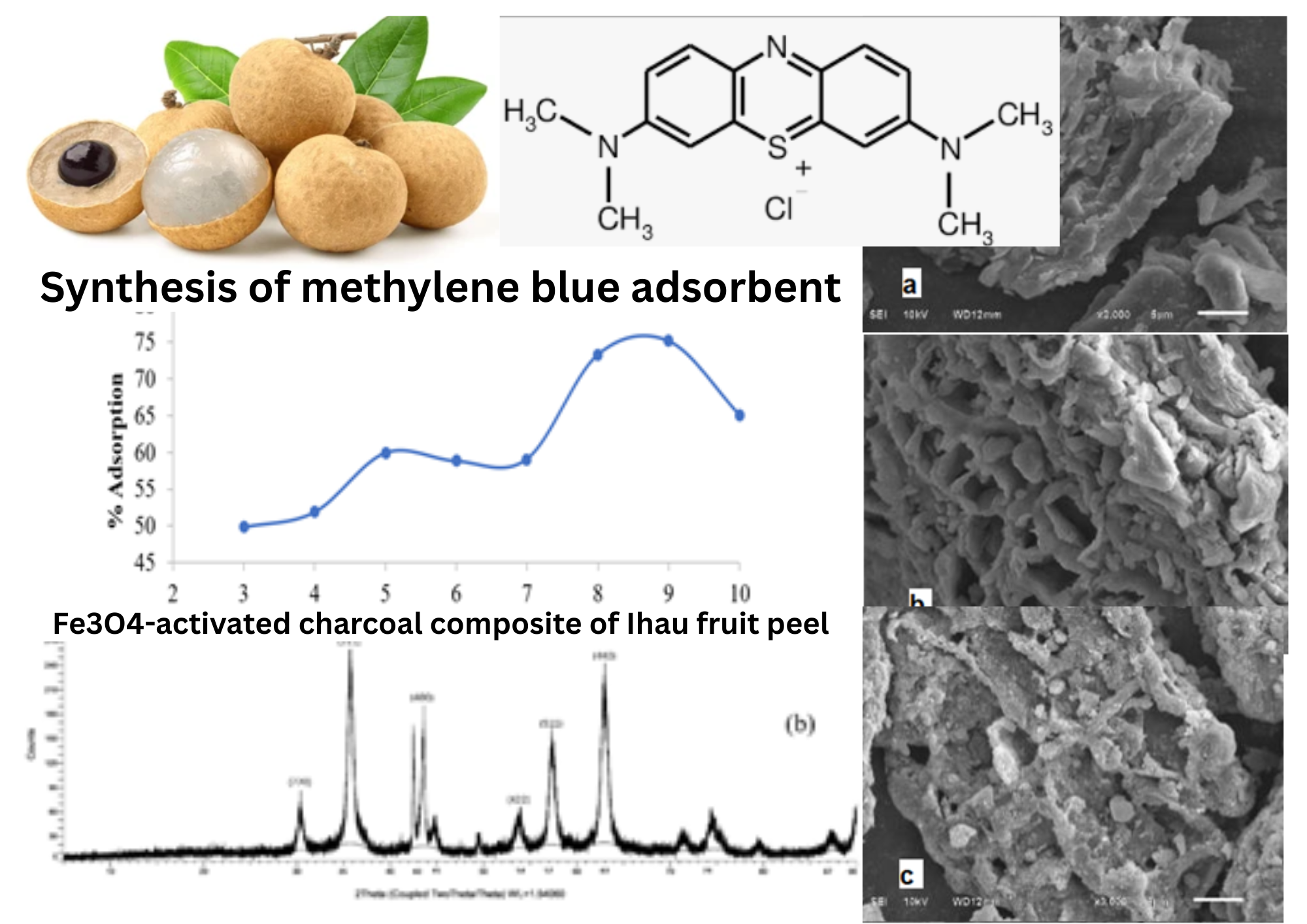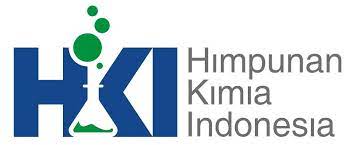
Synthesis and characterization of Fe3O4-activated charcoal composite of Ihau fruit peel (Dimocarpus longan var. malesianus Leenh.) as methylene blue adsorbent
Authors
Azizah Fithri Ananda , Teguh Wirawan , Nanang Tri WidodoDOI:
10.29303/aca.v8i2.253Published:
2025-11-28Issue:
Vol. 8 No. 2 (2025)Keywords:
Composite, Fe3O4, Active Charcoal, Ihau, Methylene BlueArticles
Downloads
How to Cite
Downloads
Metrics
Abstract
Research has been conducted on the synthesis and characterization of Fe3O4-active charcoal composite of ihau fruit peel (MAACI) as a methylene blue dye adsorbent. This research aimed to produce activated charcoal from ihau fruit peel (AACI) composited with magnetite (Fe3O4). AACI was prepared by carbonating Ihau fruit peel in a furnace at 425C for 1 hour and chemically activated by immersion in an HCl solution for 24 hours. The synthesis of MAACI was carried out using the coprecipitation method with FeCl3 • 6H2O and FeSO4 • 7H2O in a 3:2 ratio, followed by compounding with AACI. The MAACI was characterized by Fourier Transform Infrared (FTIR), Scanning Electron Microscopy (SEM) and X-Ray Diffraction (XRD). The characterization results showed that the FTIR spectrum exhibits an absorption peak at a wavenumber of 586.36 cm-1, indicating the presence of the Fe-O group. SEM analysis revealed that the MMACI has denser pores and a coarser texture compared to activated charcoal. Meanwhile, XRD results showed a diffraction pattern that matches the characterization of magnetite (Fe3O4). The adsorption of methylene blue by MAACI yielded optimum results at a pH of 9 with a contact time of 45 minutes. The maximum adsorption capacity obtained was 8.7014 mg/g, and the adsorption process followed the Langmuir isotherm model. This adsorption takes place spontaneously, is endothermic and occurs physically.
References
Ikhsany, D., Kurniawati, D., Nasra, E. & Khair, M. (2024). Pengaruh Waktu Kontak dan Kecepatan Pengadukan terhadap Penyerapan Zat Warna Methylene blue Pada Biji Kelengkeng (Dimocarpus longan Lour) dengan Metode Batch. Jurnal Pendidikan Tambusai, 8(1), 15497-15504, 2024.
Sari, R. A. K., Wirawan, T. & Sitorus, S. (2024). Adsorpsi Zat Warna dari Air Limbah Industri Rumah Tangga Sarung Tenun Samarinda Seberang dengan Menggunakan Adsorben dari Arang Aktif Serbuk Kulit Buah Lai (Durio Kutejensis (Hassk.) Becc.). Jurnal Atomik, 9(1), 1-8.
Kusuma, D. P. A. (2021). Pengolahan Air Limbah Industri Tekstil dengan Metode Koagulasi-Flokulasi (Studi Kasus Desa Soropadan, Kecamatan Pringsurat, Kabupaten Temanggung). G-SMART, 5(2), 99-103.
Herfiani, Z. H., Rezagama, A. & Nur, M. (2017). Pengolahan Limbah Cair Zat Warna Jenis Indigosol Blue (C.I Vat Blue 4) sebagai Hasil Produksi Kain Batik Menggunakan Metode Ozonasi dan Adsorpsi Arang Aktif Batok Kelapa Terhadap Parameter COD dan Warna. Jurnal Teknik Lingkungan, 6(3), 1-10.
Fitrilawati, Fauziah, Y., Maulida, G. & Syakir, N. (2022). Uji Filtrasi Model Polutan Methylen Blue Menggunakan Membran Kulit Telur. Jurnal Ilmu dan Inovasi Fisika, 06(01), 81-89.
Sugandi, D., Wahyuni, N. & Rahmalia, W. (2024). Photocatalytic Degradation of Methylene Blue by Floating TiO2-Coconut Fiber. Acta Chim. Asiana, 7(1), 437-443.
Asiah, N., Sylvia, N. & Bahri, S. (2022). Adsorpsi Zat Warna Methylene blue Menggunakan Adsorben dari Ampas Teh pada Kolom. Chemical Engineering Journal, 2(2), 75-86.
Maryudi, M., Aktawan, A. & Amelia, S. (2021). Pengolahan Limbah Pewarna Metilen Biru Menggunakan Arang Aktif dan Zeolit Aktif dengan Katalis Fe dan Oksidator Hidrogen Peroksida. Jurnal Riset Kimia, 12(2). 861-874.
Prabawati, S. Y., Aji, D. P. & Rahmadhani, D. (2024). Limbah Kulit Buah Salak Teraktivasi Asam Klorida sebagai Arang Aktif Logam Berat Timbal Pb(II) dan Kromium Cr(VI). Jurnal Kimia (Journal Of Chemistry), 18(1), 86-98.
Haura, U., Razi, F. & Meilina, H. (2017). Karakterisasi Adsorben dari Kulit Manggis dan Kinerjanya pada Adsorpsi Logam Pb(II) dan Cr(VI). Biopropal Industri, 8(1), 47-54.
Ilimu, E., Giawa, B. Alimuddin, Permana, D. & Ningsih, S. (2023). Optimasi Kombinasi Kulit Sukun (Activated Carbon) dengan Zeolit Alam sebagai Adsorben Kemasan Celup dalam Mereduksi Konsentrasi Logam Besi (Fe) dan Nikel (Ni) Sampel Air Sumur. SAINTIFIK: Jurnal Matematika, Sains, dan Pembelajarannya, 9(1), 101-108.
Muflih, F., Febrina, L. & Mulyawati, I. (2023). Pemanfaatan Limbah Kulit Jeruk Mandarin sebagai Adsorben Zat Warna Methylene Blue. Sustainable Environmental and Optimizing Industry Journal, 5(1), 46-55.
Mohadi, R., Normah, Fitri, E. S. & Palapa, N. R. Unique Adsorption Properties of Cationic Dyes Malachite Green and Rhodamine-B on Longan (Dimocarpus longan) Peel. Science and Technology Indonesia, 7(1), 115-125.
Martini, S. & Yuliwati, E. (2019). Pengaruh Proses Aktivasi Terhadap Kinerja Adsorben Organik dari Kulit Buah Melon dalam Menyerap Ion Logam Cr(III) dari Limbah Cair Industri. Distilasi, 4(2), 33-40.
Rahmawati, I. S., Widyanto, R. M., Maulidiana, A. R., Madani, M. S. & Riski, C. N. (2022). Aktivitas Antioksidan dan Antibakteri Ekstrak Etanol Buah Ihau (Dimocarpus longan var. malesianus Leenh.) Terhadap Bakteri Gram Positif (Staphylococcus aureus). Jurnal al-azhar indonesia seri sains dan teknologi, 7(2), 138.
Reknosari, E., Wirawan, T. & Koesnarpadi, S. (2020). Adsorpsi Fenol Menggunakan Adsorben Komposit Fe3O4-Arang Aktif Ampas Kopi. Jurnal Kimia Mulawarman, 18(1), 30-37.
Sastrawidana, I. D. K. (2022). Studi Efisiensi dan Isoterm Adsorpsi Remazol Black B Menggunakan Karbon dari Tempurung Kelapa yang Diaktivasi secara Pirolisis. Wahana Matematika dan Sains: Jurnal Matematika, Sains dan Pembelajarannya, 16(1), 1-11.
Kusumaningrum, D. I. P., Sudarni, D. H. A. & Wahyuningsih, S. (2022). Optimasi Pengaruh Waktu Kontak dan Dosis Adsorben Limbah Daun Kayu Putih (Melaleuca cajuputi) dengan Metode Isoterm Adsorpsi Langmuir. Jurnal Teknik Kimia USU, 11(2), 72-79.
Neolaka, Y. A. B., Lawa, Y., Naar, J. N., Nubatonis, Y. K. & Riwu, A. A. P. (2019). Studi Termodinamika Adsorpsi Pb(II) Menggunakan Adsorben Magnetik GO-Fe3O4 yang Disintesis dari Kayu Kusambi (Schleichera oleosa). Jurnal Saintek Lahan Kering, 2(2), 49-51.
Sam, R. F., Wirawan, T. & Aziz, A. (2024). Adsorpsi Zat Warna Rhodamine B Menggunakan Serbuk Kulit Buah Lai (Durio kutejensis (Hassk.) Becc.) Sebagai Adsorben. Jurnal Atomik, 9(2), 96-104.
Wati, A. M., Mahatmanti, F. W. & Prasetya, J. A. T. (2022). Adsorpsi Metilen Biru oleh Abu Layang Batu Bara yang Teraktivasi Menggunakan Proses Hidrotermal dengan Bantuan Gelombang Mikro. Jurnal Penelitian Kimia, 18(1), 58-69.
Herawati, D., Santoso, S. D. & Amalina, I. (2018). Kondisi Optimum Adsorpsi-Fluidisasi Zat Warna Limbah Tekstil Menggunakan Adsorben Jantung Pisang. Jurnal SainHealth, 2(1), 1-7.
Huda, T. & Yulitaningtyas, T. K. (2018). Kajian Adsorpsi Methylene Blue Menggunakan Selulosa dari Alang-Alang. Indonesian Journal of Chemical Analysis (IJCA), 1(01), 9-19.
Sjafruddin, R. Fajar, Nisa, K., Sari, N. I. & Ferawati, A. A. (2022). Model Isoterm Adsorpsi Karbon Aktif dari Ampas Tebu pada Penjerapan Zat Warna Metilen Biru. Seminar Nasional Hasil Penelitian & Pengabdian Kepada Masyarakat (SNP2M), 7(pp), 121-126.
Bahri, S., Muhdarina, Nurhayati & Andiyani, F. (2011). Isoterma dan Termodinamika Adsorpsi Kation Cu2+ Fasa Berair pada Lempung Cengar Terpilar. Jurnal Natur Indonesia, 14(1), 7-13.
License
Copyright (c) 2025 Azizah Fithri Ananda, Teguh Wirawan, Nanang Tri Widodo

This work is licensed under a Creative Commons Attribution-NonCommercial-ShareAlike 4.0 International License.
Authors who publish with ACA: Acta Chimica Asiana agree to the following terms:
- Authors retain copyright and grant the journal right of first publication with the work simultaneously licensed under a Creative Commons Attribution-NonCommercial-ShareAlike 4.0 International License. This license allows authors to use all articles, data sets, graphics, and appendices in data mining applications, search engines, web sites, blogs, and other platforms by providing an appropriate reference. The journal allows the author(s) to hold the copyright without restrictions and will retain publishing rights without restrictions.
- Authors are able to enter into separate, additional contractual arrangements for the non-exclusive distribution of the journal's published version of the work (e.g., post it to an institutional repository or publish it in a book), with an acknowledgement of its initial publication in ACA: Acta Chimica Asiana.
- Authors are permitted and encouraged to post their work online (e.g., in institutional repositories or on their website) prior to and during the submission process, as it can lead to productive exchanges, as well as earlier and greater citation of published work (See The Effect of Open Access).





 Indonesian Chemical Society, Chapter Nusa Tenggara. Jalan Majapahit 62 Mataram, University of Mataram, 83125, Indonesia
Indonesian Chemical Society, Chapter Nusa Tenggara. Jalan Majapahit 62 Mataram, University of Mataram, 83125, Indonesia





